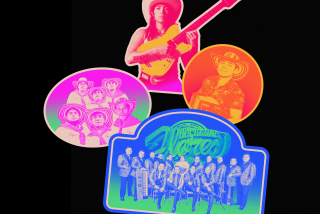Argentine, Jamaican, Caribbean Sounds to the Fore
The interactive musical stream flowing between north and south lately has tended to focus on the country that captivates so many other areas of the media--Cuba. And there’s no question that the blendings between jazz and the rich rhythmic currents of the island nation have been creating remarkably palatable music for decades.
But jazz has other connections to the south, as well. Here are some new releases illustrating how America’s most original musical expression has linked up with other cultural areas:
Gary Burton, “Libertango: The Music of Astor Piazzolla” (*** 1/2, Concord Jazz). The remarkable parallels between tango in Argentina and jazz in the U.S. have often been noted. Both originated in urban bars and bordellos, both were blendings of music from different sources--European, African and local--and both were closely connected with dancing. But there is one additional similarity, not often mentioned, but described by Burton in the liner notes of this new recording:
“Usually, a country’s national music remains simple in structure,” Burton writes. “The average person can sing it, play it or dance to it. But tango, like jazz, brought together the considerably developed traditions of Western European music and local folk influences and evolved into a sophisticated art form requiring the highest levels of musicianship.”
Burton is right on all counts, and what is really fascinating about this album--as has been true with his previous tango involvements--is the ease with which jazz and tango, both sophisticated artistic disciplines, come together. There’s also the sense of underlying melodic intimacy and rhythmic passion that links the two, despite some technical differences (especially in rhythm and approaches to soloing).
One of the additional reasons for that connection is the program of music by Piazzolla--tango’s Louis Armstrong, Charlie Parker and Duke Ellington rolled into one incisive musical personality. Although Piazzolla was born in Argentina, he spent most of his childhood--until he was 16--living in New York City and managing to hear Duke Ellington and Cab Calloway at the Cotton Club. (He died in 1992 at 71.)
The vibraphone is not an instrument associated with tango, yet Burton--performing with several artists who were regulars with Piazzolla--blends the instrument stunningly within the music’s lush, often sensual, currents of emotion. There is stunning piano work from the remarkable Pablo Ziegler and superb violin performances by Fernando Suarez-Paz on “Escualdo,” a work written for him by Piazzolla, and the sensual classic “Invierno Porteno.”
Is it jazz? In origin, no; in delivery, sometimes yes. But, above all, it is music performed with the spirit, enthusiasm and swing of jazz. And that swing, although its 3+3+2 rhythmic emphasis differs from the lifting flow of jazz, possesses the same kind of body-moving elements. Not a complete jazz experience as such, perhaps, but music with enough jazz subtext to prove irresistible to the receptive listener.
(On May 11, the Oxford University Press will publish “Le Grand Tango: The Life and Music of Astor Piazzolla,” by Maria Susana Azzi and Simon Collier. The first full-scale Piazzolla biography in English, it’s a comprehensive and insightful view into the life of one of the 20th century’s most important musical figures.)
Monty Alexander, “Monty Meets Sly and Robbie” (** 1/2, Telarc Records). Jamaica’s Alexander has been a significant jazz figure since he surfaced in the ‘60s working with, among others, Frank Sinatra, Milt Jackson, Dizzy Gillespie, Sonny Rollins and numerous others. But the pianist also has had a continuing fascination with the music of his home--impressively apparent in last year’s album “The Music of Bob Marley.” This time out, Alexander has teamed with the reggae drum and bass team of Sly Dunbar and Robbie Shakespeare to perform a collection of ‘50s and ‘60s hits such as Ramsey Lewis’ “The ‘In’ Crowd,” Joe Zawinul’s “Mercy, Mercy, Mercy,” the Stylistics’ “People Make the World Go ‘Round” and Lee Morgan’s “The Sidewinder.”
The music is spirited, primarily as the result of Alexander’s irresistibly swinging style. But the bass and drum accompaniment--although it may attract the attention of a younger audience--does little to energize the music. And one can only speculate on how much more effective these performances would have been, as jazz, had a rhythm section of such familiar Alexander associates as bassist John Clayton and drummer Jeff Hamilton been present.
Andy Narell, “Fire in the Engine Room” (** 1/2, Heads Up Records). Steel pan artist Narell has assembled three ensembles for his latest album, hailing from Cuba, Argentina, Peru, Martinique, Jamaica and Guadeloupe, as well as Europe and the United States. The title traces to Trinidadian slang for the rhythmic center of a steel pan orchestra.
The music, all of it composed by Narell, is similarly far-reaching, with traces of Caribbean rhythms, Brazilian samba and occasional hip-hop beats. But with Narell as the sole unifying element, the album has no real center, reaching out in too many diverse directions. Narell’s tunes are brightly melodic, with distinct tropical flavors, but the compositions and his steel pan playing lack the layered intensity of his work with the Caribbean Jazz Project. Call it a great soundtrack for a drive up U.S. 1 to Big Sur.
Jesus “Chucho” Valdes, “Live at the Village Vanguard” (***, Blue Note). OK, so we can’t get through even one southward-looking roundup without at least one Cuban entry. And few are more appropriate than pianist Valdes, whose last album, “Briyumbo Palo Congo,” received a Grammy nomination.
The live performance, his first for Blue Note, showcases him in the company of his regular group--bassist Francisco Rubio Pampin, trap drummer Raul Pineda Roque and conga and bata drummer Roberto Vicaino Guillot. His sister, Mayra Caridad Valdes, adds her throaty sound and idiosyncratic scatting to a high-voltage rendering titled “Drume Negrita.”
Typically, Valdes demonstrates his creative reach by including a standard ballad, “My Funny Valentine” (done over a danzon rhythm), a bebop mambo in his own “To Bud Powell” and, as a closing encore, the early rhythms of the habanera in “Lorraine’s Habanera,” a melodic piece composed for Village Vanguard owner Lorraine Gordon. Valdes’ style may appear a bit overblown and rhapsodic for listeners who favor a more spare approach to jazz, but his manner and method are unquestionably his own.
More to Read
The biggest entertainment stories
Get our big stories about Hollywood, film, television, music, arts, culture and more right in your inbox as soon as they publish.
You may occasionally receive promotional content from the Los Angeles Times.










